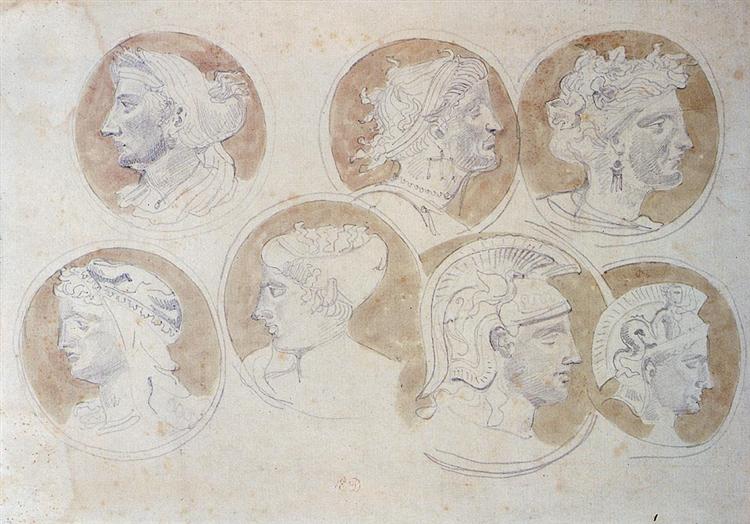Descrição
Eugène Delacroix, um dos expoentes mais proeminentes do romantismo, é conhecido não apenas por suas composições pictóricas magistrais, mas também por sua profunda apreciação pela arte dos tempos passados. Seu trabalho "Estudos de Medalhões Antigos" (1825) oferece um exemplo claro desse fascínio, além de destacar seu virtuosismo na representação e seu interesse na iconografia clássica. Esse pintura, Embora à primeira vista possa parecer um exercício de estudo ou uma mera representação, convida a reflexão sobre a interseção do passado e do presente no processo criativo do artista.
O trabalho consiste em uma série de medalhões que capturam figuras emblemáticas da antiguidade. O uso da cor e a atenção aos detalhes são evidentes em cada uma das peças representadas. Os medalhões, que parecem flutuar em um fundo neutro, são cuidadosamente projetados para destacar as qualidades físicas dos personagens. As cores usadas são sutis, mas são impregnadas com uma energia vibrante que reflete o domínio de Delacroix na manipulação de petróleo. Essa abordagem da cor não é apenas um testemunho de sua capacidade técnica, mas também revela sua busca pela beleza no clássico, um tema recorrente em seu trabalho.
Quanto à composição, o Delacroix usa uma ordem deliberada que guia o olhar do espectador através dos diferentes medalhões. Cada figura, embora individual, faz parte de um todo coeso. As expressões e posições faciais dos personagens sugerem uma narrativa intrínseca que convida a contemplação. Embora o espectador não receba uma história específica, a presença dessas figuras icônicas sugere um fundo de mitologia e renascimento cultural. A escolha dos medalhões, que são uma forma de arte tremendamente popular na antiguidade, reflete o interesse do artista em se conectar com a história e o legado cultural das civilizações passadas.
Um elemento fascinante de "estudos de medalhões antigos" é o método de trabalho da Delacroix. Sua inclinação para estudos preparatórios e esboços foi emblemática de seu processo criativo. Muitas vezes, seus estudos eram mais do que simples rascunhos; Eles se tornaram explorações de cor, forma e emoção. Essa abordagem pode ser vista na maneira como os medalhões tratam, onde cada elemento parece estar no diálogo não apenas com os outros medalhões, mas também com o espectador. Esse diálogo visual convida uma apreciação mais profunda da arte clássica, destacando como você pode influenciar o contexto e a prática artística contemporânea.
O romantismo de Delacroix também se manifesta neste trabalho através de sua capacidade de infundir vida a figuras que são, em essência, produtos de uma era passada. Através de sua interpretação, a Delacroix não apenas documenta a estética da antiguidade, mas também a revitaliza, dando -lhe um novo contexto dentro da estrutura de sua própria era. A relação entre arte antiga e contemporânea, a evocação de emoções e a celebração da história são questões que persistem ao longo de sua carreira.
"Estudos de medalhões antigos", assim, se torna mais do que uma simples série de estudos; É um testemunho da capacidade de Delacroix de se conectar com o passado e reinterpretá -lo por seu estilo pessoal, caracterizado por um uso apaixonado da cor e uma composição cheia de movimento. O trabalho, através de seus medalhões, nos convida a examinar não apenas a estética de um tempo anterior, mas também a refletir sobre a natureza da própria arte. O domínio de Delacroix neste pintura Não apenas destaca sua capacidade técnica, mas também seu profundo entendimento do papel que a arte desempenha na continuidade da cultura e da história.
KUADROS ©, um pintura famoso em sua parede.
Reproduções de pinturas petróleo feito à mão, com a qualidade dos artistas profissionais e o selo distinto de KUADROS ©.
Serviço de reprodução de imagens com garantia de satisfação. Se você não está completamente satisfeito com a réplica de seu pintura, Reembolsamos seu dinheiro 100%.

